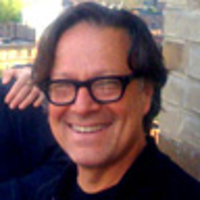In the 1980s, Neil Winokur would invite his friends over in the early evening, photograph them in his New York loft, and offer them a drink or two before they headed out together into the downtown Manhattan nightlife. Some, such as Andy Warhol and Alex Katz, were already art world fixtures, but others, like Nan Goldin, Betsey Johnson and William Wegman, were just the people he knew from the neighborhood, so to speak, who were only beginning to experience fame. Today Winokur’s portraits compose an outré pantheon of arts and letters, and 40 of them are currently on exhibit at Janet Borden Inc. through November 25.
Click the Image Below to View Our Gallery

It seems remarkable that the eclectic group Winokur got to know knew from the casual circumstances of his daily life--afternoons at the Strand Bookstore, where he worked, or evenings at The Mudd Club—formed a circle of influence at the center of the zeitgeist. He sensed the importance of some of his friends—like Kiki Smith or Philip Glass—who were as yet not well known, and he made their portraits, he explained, as if “to be their court photographer, in a way.” In a recent phone conversation, he called it an odd coincidence that so many of the people he knew and photographed more than 25 years ago would become so famous. “I’m glad they did,” he said. “Cindy Sherman has always been one of my favorite photographers, especially her early work.”
ADVERTISEMENT
• Art Beast: The Best of Art, Photography, and DesignWinokur set up his subjects in front of a paper backdrop on a pulley system in his living room. He would ask them to sit before his 4 x 5 camera not three feet away. He lit them with two strobe lights, and made these portraits. The whole thing would take half an hour. “When I began photographing people, my backgrounds were very light colored,” he said. “Eventually I figured out that if I used colored gels with colored backdrops, I could get much brighter, saturated colors. These days I mix gels to get more and more colors. I guess my love of bright, super-saturated colors has something to do with 1960s pop art, and with the keyed up palette of acrylic paints.”
His drug-colored, candy-coated portraits have a deadpan anonymity about them, as if each one were a photo I.D. for a character in Peewee’s Playhouse. Winokur’s subjects appear to be the same color as the background, as if you were seeing them under the glow of club lights, which is what the milieu of downtown Manhattan in the 1980s felt like before the AIDS epidemic changed the composition of that entire creative community. The clothing, make-up and hairstyles of Winokur’s subjects tell us less about the individuals than about the sensibility of that cultural moment.
Portraiture is a funny thing. The real conundrum about the genre is whether a portrait is a description of the subject or, in fact, a self-portrait of the photographer. Nadar (Gaspard-Felix Tournachon) photographed his friends, too, the artists and writers who formed a circle of influence in Paris in the 19th century, including Charles Baudelaire, Sarah Bernhardt, Gustave Courbet, and Eugene Delacroix. Today, his portraits are distinctly recognizable as Nadars as much as they register the likenesses of individual historic figures. The same is true of portraits by Irving Penn, as distinct from portraits by Richard Avedon, often of the same people. The signature of each photographer is what we determine as being a portrait by Avedon or Penn before even recognizing the subject. The fizzy-pop colors in which Neil Winokur rendered so many up-and-coming cultural figures is clearly the signature that establishes his work as his own.
“When I started, my influence was the Hollywood glamour portrait,” Winokur said. “I thought if I did these very Pop head shots, the color background makes the person stand out. The photographs reveal every detail while telling you nothing about the person except what they present to the camera. You can make up your own story about the person, because that is the only information you have.”
Winokur’s portraits are not definitive observations of each individual in this tribe, but, rather, glimpses of what they all looked like once upon a time. Here, for example, are David Byrne, Laurie Simmons and Robert Wilson when they were still young, before their reputations had been fully secured. You might think of this work as an early class portrait of the last generation’s avant-garde before they turned into the cultural elders they have become today.
Plus: Check out Art Beast for galleries, interviews with artists, and photos from the hottest parties.
Philip Gefter was a picture editor at The New York Times and wrote regularly about photography for the paper. His book of essays, Photography After Frank, was recently published by Aperture. He is currently producing a feature-length documentary on Bill Cunningham of the Times, and working on a biography of Sam Wagstaff.





